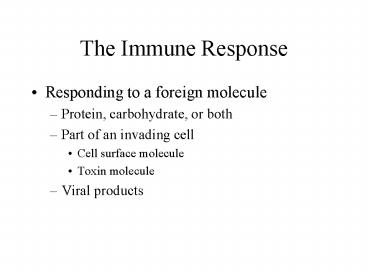The Immune Response - PowerPoint PPT Presentation
1 / 44
Title: The Immune Response
1
The Immune Response
- Responding to a foreign molecule
- Protein, carbohydrate, or both
- Part of an invading cell
- Cell surface molecule
- Toxin molecule
- Viral products
2
The Immune Response
- Involves many cell types
- Specific and non-specific mechanisms
- Phagocytosis
- Antibodies
- Antigen receptors
- Elements of control
- Memory
3
Antigens
- A molecule that causes an immune response.
- An invading cell or part of an invading cell.
- Elicit antibody production
- Target the antigen
- Bind to the antigen
- Inactivate the antigen (several ways)
4
The Immune Response
- A concerted effort by immune cells to rid the
body of invading organisms and/or molecules. - There are many different kinds of immune cells
that participate. - There is cellular communication
5
Two Arms of the Immune System
- Cell mediated
- Involves T-cell lyphocytes
- Direct attack against foreign cells
- Organisms
- Tissues (transplants)
- Parasites
- Direct attack against infected host cells
- Display of viral proteins
- Cancer cells
- Helper Function
6
Two Arms of the Immune System
- Humoral Immune System
- Antibody Mediated
- Found in Extracellular Fluids
- Produced by B-cell Lymphocytes
- Antibodies recognize
- Bacteria
- Toxins
- Viruses (circulating)
7
Antibodies and Antigens
- Antigens
- Non-self
- Proteins or carbohydrates (of invader)
- Antigenic determinant
- Specific regions that react with antibody
- Epitope
- Antigens have many epitopes
- Many potenetial antibody binding sites
8
Antibodies and Antigens
- Antibodies
- Specific for one epitope of antigen
- Molecular fit
- Antigen binding site
- Two idential antigen binding sites per antibody
- Valence Number
- Antigens bound per antibody molecule
9
Antigenic determinate sites pg. 464
10
Antibodies
- Immunoglobulins, gamma globulins
- Specific proteins
- Found in bloodstream mostly
- Molecular weight 150,000 - 900,000
- Made by B-cells
11
Antibodies
- Immunoglobulins, gamma globulins
12
Antibody Structure
- Single antibody molecule (monomer)
- 4 protein chains
- 2 Heavy (H)
- 2 Light (L)
- Disulfide bonds
- Two antigen binding sites
13
Antibody structure pg. 465
14
Antibody Structure
- Variable Regions
- At ends of H and L chains
- Both involved in binding antigen
- Two antigen binding sites per monomer
15
Antibody structure pg. 465
C constant V variable - change with the antigen
Complement attaches
16
Antibody Structure
- Variable regions
- Vary in amino acid sequence
- Different antigens recognized
- Extremely Variable
17
Antibody structure pg. 465
18
Antibody Structure
- Constant Regions
- Stem of Immunoglobin molecule
- Above the variable region
- Fc region
- Special Characteristics
- Binds host cell receptors
- Binds Complement
- Specifig Ig function
19
Antigenic Determinant Diversity
- How many possible antigens must be recognized?
- How are antibodies made?
- Do they pre-exist?
- Are they made to-order by following the antigen
as template? - Is synthesis random?
20
Ig Genes
- Information of antibody structure is encoded in
genes. - DNA RNA Amino Acid Sequence
- Ig genes are composed of 4 sets of mini-gene
families - Variable
- Diversity
- Joining
- Constant
21
Ig Genes
- Gene family size allows great diversity
- Gene structure allows great diversity.
- Variable Genes 100
- Diversity Genes 12
- Joining Genes 4
- Genes rearrange to include Constant region
- Combine 1 of each family
- V D J C (heavy Chain)
22
Ig Genes
- Combinations of Heavy Chains
- 100x12x4x14800
- Combinations of Light Chains
- 400
- Total Combinations
- 4800x4001,920,000
23
Ig Gene Rearrangement
24
Classes of antibodies pg. 466
1.
Crosses placenta
25
Classes of antibodies pg. 466
2.
26
Classes of antibodies pg. 466
3.
27
Classes of antibodies pg. 466
4.
28
Classes of antibodies pg. 466
5.
Bind to mast and basophile cells
29
Differentiation of B cells Pg. 468
30
Antibody synthesis pg. 4691. Macrophages
phagocytize microorganisms and present the
antigenic determinant sites to the specific B cell
31
Antibody synthesis pg. 4692. B cell divides
into memory and plasma cell lines
32
Antibody synthesis pg. 4693. Plasma cells
secrete antibodies into the bloodstream
33
Antibody synthesis pg. 4694. After second
exposure to the same antigen, the memory cells
secrete antibodies into the bloodstream
34
Protective mechanisms of binding antibodies to
antigens pg. 470
1.
Particulate antigen
35
Protective mechanisms of binding antibodies to
antigens pg. 470
2.
36
Protective mechanisms of binding antibodies to
antigens pg. 470
3.
37
Protective mechanisms of binding antibodies to
antigens pg. 470
4.
Complement group of at least 11 non-specific
proteins in serum
38
Protective mechanisms of binding antibodies to
antigens pg. 470
5.
39
Protective mechanisms of binding antibodies to
antigens pg. 470
6.
40
Time frame for antibody synthesis
41
The primary and secondary immune responses pg. 471
42
The primary and secondary immune responses pg. 471
Delayed 7 days plasma cells low level of
antibodies not long lasting
43
The primary and secondary immune responses pg. 471
No delay memory cells high levels of
antibody long lasting
44
Ways of acquiring antibodies pg. 462

























![V] THE HEALTHY IMMUNE SYSTEM PowerPoint PPT Presentation](https://s3.amazonaws.com/images.powershow.com/8447524.th0.jpg?_=20170129021)





